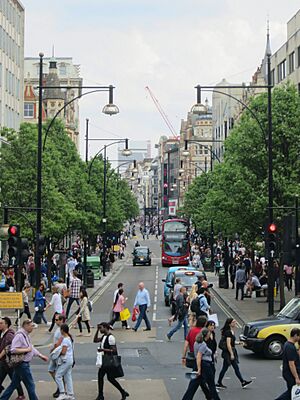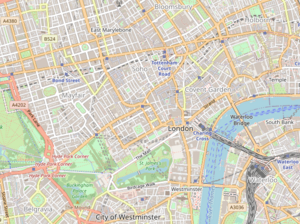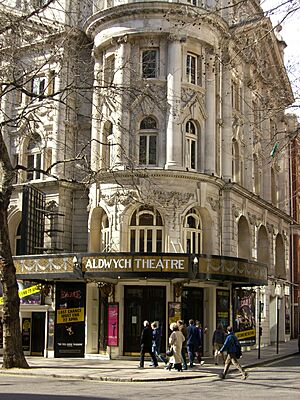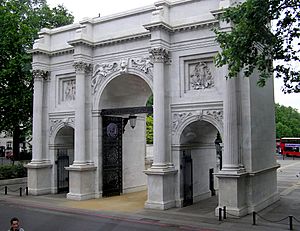West End of London facts for kids
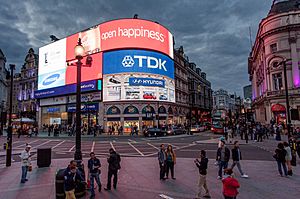
The West End of London is a famous area in Central London, England. It's located west of the City of London and north of the River Thames. This part of London is packed with major tourist spots, shops, businesses, government buildings, and fun entertainment places, including many West End theatres.
People started using the name "West End" in the early 1800s. It described the fancy areas west of Charing Cross. The West End covers parts of two London boroughs: Westminster and Camden.
While the City of London is known for banking and finance, the West End is the main place for shopping and entertainment. It's the biggest business area in the United Kingdom. You can compare it to famous city centers like Midtown Manhattan in New York City or Shibuya in Tokyo. Renting office space here is very expensive.
Contents
History of the West End
Long ago, Medieval London had two main cities right next to each other. There was the City of London in the east and the City of Westminster in the west.
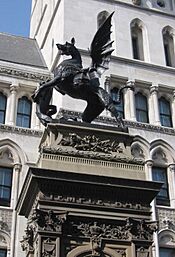
Over time, these two areas grew together to form modern London. But they still kept their own special features. For example, the City of London has its own police force. The City of London became a hub for banking, finance, and legal work. Westminster, on the other hand, became known for fun, shopping, and entertainment. It also became home to the government, universities, and embassies. The West End we know today is closely linked to this part of central London.
The West End is located west of the old Roman and medieval City of London. Rich people preferred to live here because the wind usually blew smoke from the crowded city away from them. It was also close to the royal palace at Palace of Westminster. This palace is now where the parliament meets. The West End is mostly within the City of Westminster.
Starting in the 1660s, the West End began to develop. During the late 1600s, 1700s, and 1800s, grand palaces and expensive houses were built. Fashionable shops and entertainment venues also appeared. Areas closer to the City, like Holborn and Covent Garden, used to have poorer communities. These areas were later cleared and rebuilt in the 1800s.
What Areas Make Up the West End?
The West End isn't an official area with fixed borders. People in London use the term in a general way. So, what exactly counts as the West End can be a bit of a discussion!
In 2005, the Westminster City Council released a report about the West End. It included areas like Covent Garden, Soho, Chinatown, and Leicester Square. It also mentioned the famous shopping streets: Oxford Street, Regent Street, and Bond Street. The report also covered the area around Trafalgar Square, the Strand, and Aldwych. And, of course, the area known as Theatreland (where all the theatres are!). Some nearby areas like Edgware Road and Victoria Embankment were also mentioned.
Another book, West End Chronicles (2006), lists different districts. It says the West End includes Mayfair, Soho, Covent Garden, Fitzrovia, and Marylebone. By this definition, the West End borders Temple, Holborn, and Bloomsbury to the east. To the north, it borders Regent's Park. To the west, you'll find Paddington, Hyde Park, and Knightsbridge. And to the south, it borders Victoria and Westminster. Some people also include Bloomsbury within the West End.
There's even a special election area in the City of Westminster called "West End". This area includes some of the richest parts of the borough. These include Soho, Mayfair, and parts of southern Marylebone. In 2011, about 10,575 people lived in this area.
Famous Streets in the West End
- Albemarle Street
- Baker Street
- Bond Street
- Carnaby Street
- Charing Cross Road
- Denmark Street
- Great Marlborough Street
- Great Portland Street
- Harley Street
- Haymarket
- High Holborn
- Jermyn Street
- Lisson Grove
- Kingsway
- Old Compton Street
- Oxford Street
- Pall Mall
- Park Lane
- Piccadilly
- Regent Street
- Savile Row
- Shaftesbury Avenue
- Strand
- The Mall
- Wardour Street
Notable Squares and Circuses
The West End has many well-known public squares and circuses (roundabouts).
- Berkeley Square
- Cambridge Circus
- Cavendish Square
- Grosvenor Square
- Hanover Square
- Hyde Park Corner
- Leicester Square
- Manchester Square
- Marble Arch
- Oxford Circus
- Parliament Square
- Piccadilly Circus
- Portman Square
- Russell Square
- Soho Square
- St James's Square
- St Giles Circus
- Trafalgar Square
Getting Around: West End Tube Stations
The London Underground (also known as the "Tube") has many stations in the West End.
- Baker Street
- Bond Street
- Charing Cross
- Covent Garden
- Embankment
- Goodge Street
- Great Portland Street
- Green Park
- Holborn
- Hyde Park Corner
- Leicester Square
- Marble Arch
- Oxford Circus
- Piccadilly Circus
- Regent's Park
- Russell Square
- Tottenham Court Road
- Warren Street
See also
 In Spanish: West End (Londres) para niños
In Spanish: West End (Londres) para niños


